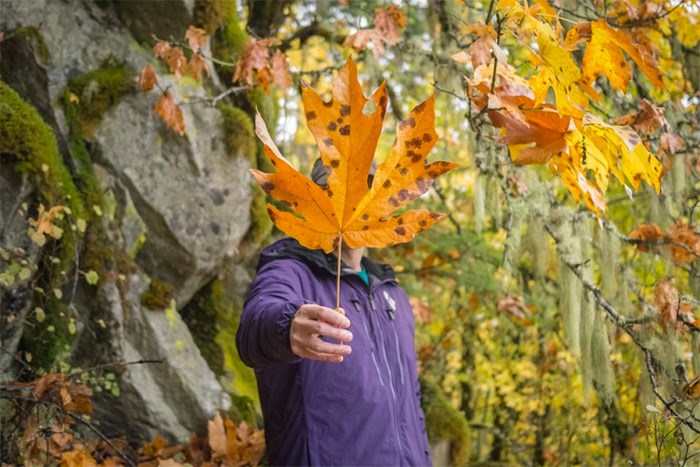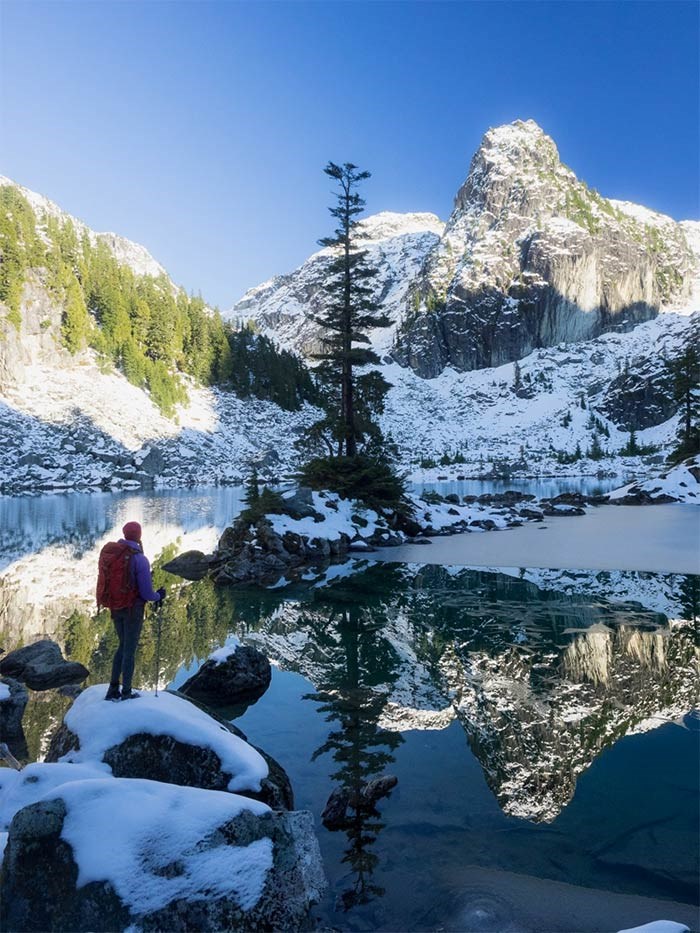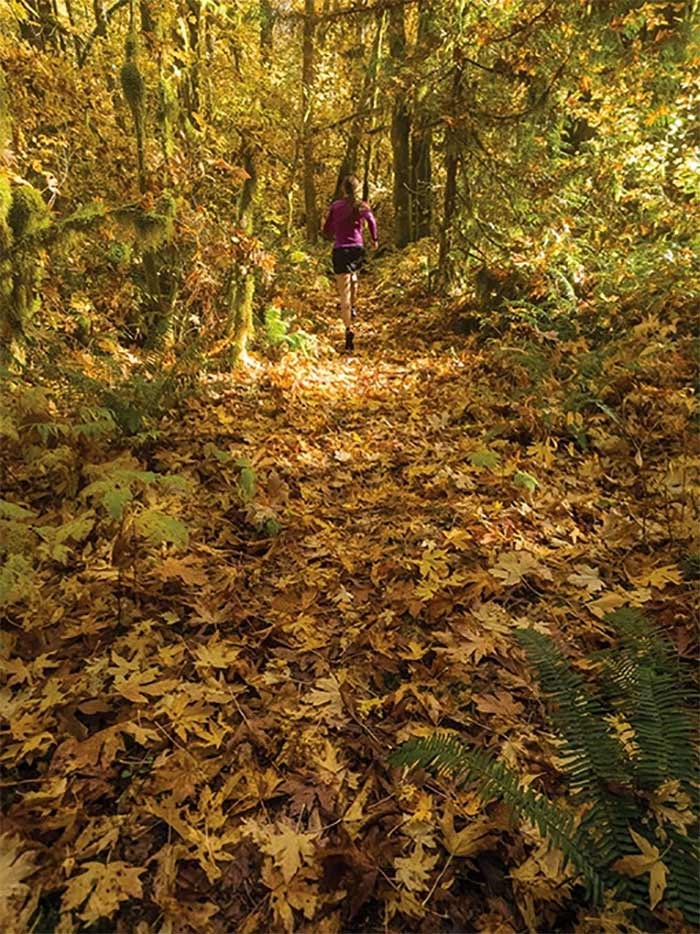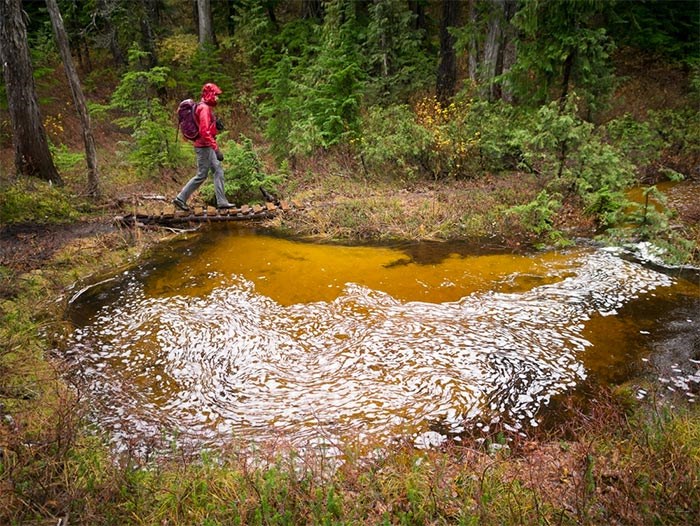 Walking the trails near the “Area 44” climbing crags near Squamish. Photo: Leigh and Spring McClurg
Walking the trails near the “Area 44” climbing crags near Squamish. Photo: Leigh and Spring McClurg
With the evenings beginning to get colder we’re starting to get those first few hints that fall and then winter are around the corner. I was out in Squamish the other evening, in shorts and a T-shirt, the blue hues of dusk just visible out across Howe Sound and I shivered. It felt like it had been a while since I had needed a jacket to feel warm.
Fall, for many, is their favourite time of year on the west coast. The weekend fervour from visitors excited to see our little slice of heaven here in Squamish begins to abate. The mosquitoes down by the rivers are disappearing and the leaves are becoming golden and drifting down from the sky, a portent for the snowflakes that will follow them in our mountains a short while later.
Fall has been described as a tall glass of ice water in the shade after a scorching day in the sun at the beach. The cool can be refreshing, especially after a summer as hot and long as the one we have experienced.
For many, the first cold snap of the fall and the first fresh snow adorning Mount Garibaldi and the Tantalus Range can be a time to pack away the hiking and camping gear for the season. While there are some challenges getting out into nature and up into the mountains in the fall, it isn’t necessarily a time to stop entirely. With a little preparation and planning, you can still experience these wild places through the fall months.
The following is some advice on how to approach gearing up for hiking in the fall, and the weather that accompanies it, around Squamish:
Temper expectations
First and foremost is a resignation that simply getting out there is the reward. Even if you just spend the day in the forest and find the snow line while being rained on, it’s important to have the disposition that this was not a failure.
The fall is not the time of year to set your ambitions high. If there was some long hike to a tall mountain that you’d been hoping to complete in the summer, but never got around to, then the fall might not be the best time to attempt it. The days are shorter, the evenings are colder, and the weather can be fickle.
Try and choose an objective with shelter at some point, like Red Heather meadows on the way to Elfin Lakes in Garibaldi Provincial Park.
Our rainforest here, when swollen from a fresh storm, with mushrooms springing up from nearly every damp log and creeks appearing where once they sat dry, is always a fine reward for the effort to get out rather than simply stay inside.
 Overlooking Watersprite Lake. – Leigh & Spring McClurg
Overlooking Watersprite Lake. – Leigh & Spring McClurg
Footwear
While in the summer I mostly wear trail shoes or runners, in the fall I will frequently wear proper hiking boots with a Gore-Tex liner. If needed, I will carry gaiters with me and a spare pair of socks in my pack.
Even if you don’t expect it to rain, the dew in the forest on all the foliage can feel like a torrent of water on your feet as you brush through it, shaking it loose. I’ve had wetter and colder feet sometimes from seeing clear, crisp skies overhead and heading out in lighter mesh footwear instead of a pair of shoes that is more water resistant.
Gore-Tex ( waterproof/breathable) liners can create the issue where your feet will sweat inside your boot and become wet. From personal experience, this is less of an issue in the fall when the temperatures are cooler and, in general, you don’t sweat as much.
Pants
Rather than wearing incredibly warm pants or completely waterproof pants I prefer those made from a material that wicks away moisture and also dries extremely fast. Enquire at your local outdoor recreation store in Squamish about these options for pants.
The fall is an excellent time of year for quick drying fabrics as it can still be hot like summer when exposed to the direct sun, causing you to sweat, but then cold like winter in the shade and wet in the forest from past rain and morning dew.
I carry a lightweight waterproof pair of pull-over pants for when persistent rain is expected.
If I am heading up into snow I will carry a base layer of wool leggings or wear them from the start if hiking in late fall and dealing with freezing temperatures. The benefit of Merino wool is that even if it gets wet it will still retain heat keeping you warmer than other options like cotton.
 The leaf-covered trails around Squamish are beautiful come autumn. – Leigh & Spring McClurg
The leaf-covered trails around Squamish are beautiful come autumn. – Leigh & Spring McClurg
Top
Your torso and core are the most important parts of your body when it comes to planning for fall weather conditions. In general, that is where the majority of your body’s heat is produced and stored.
Your concerns are managing sweat and getting cold from being exposed to wind and/or rain.
A system of layering clothes is best. The conditions can fluctuate between feeling like summer and winter in the fall. I will usually wear a long sleeve, lightweight Merino wool base layer, a fleece mid layer and then carry a Gore-Tex hardshell jacket in case of rain. I will also carry a down puffy jacket for when I stop to eat lunch.
Some people will carry a spare base layer for emergency use if they get really wet or need to sleep out due to an accident. This can be a valuable consideration, especially if your base layer has gotten wet from sweat or precipitation during the day.
Equipment
The fall can be the hardest time of year when thinking about packing your bag. On a number of occasions, I’ve carried a heavy pack with gear specific for winter conditions and experienced mild summer-like conditions instead.
In the early fall, when there isn’t enough snow to ski without hitting roots and rocks, I’ll either carry snowshoes or micro-spikes. These can be valuable if deeper than expected snow is encountered or if fresh rainfall on the trail has frozen and become dangerously icy.
Bring more calories than you think you’ll need. During those late fall adventures, I frequently underestimate how much energy my body is using in the cold and bring only a handful of granola bars like I do in summer. Choose foods that are fatty and have protein like cheese, meat, and nuts over sugary foods.
Overall though, remember to have fun! You’ll be one of a special few who continues to get out and hike when toque season returns. Remember to say hello on the trails as you pass other hikers out there, they’re part of your tribe now who doesn’t let the seasons dictate where they go. Maybe I’ll see you out there on the many amazing trails and high places near our home in Squamish.
 Hiking the trails above the Sea to Sky Gondola in the rain. – Leigh & Spring McClurg
Hiking the trails above the Sea to Sky Gondola in the rain. – Leigh & Spring McClurg



